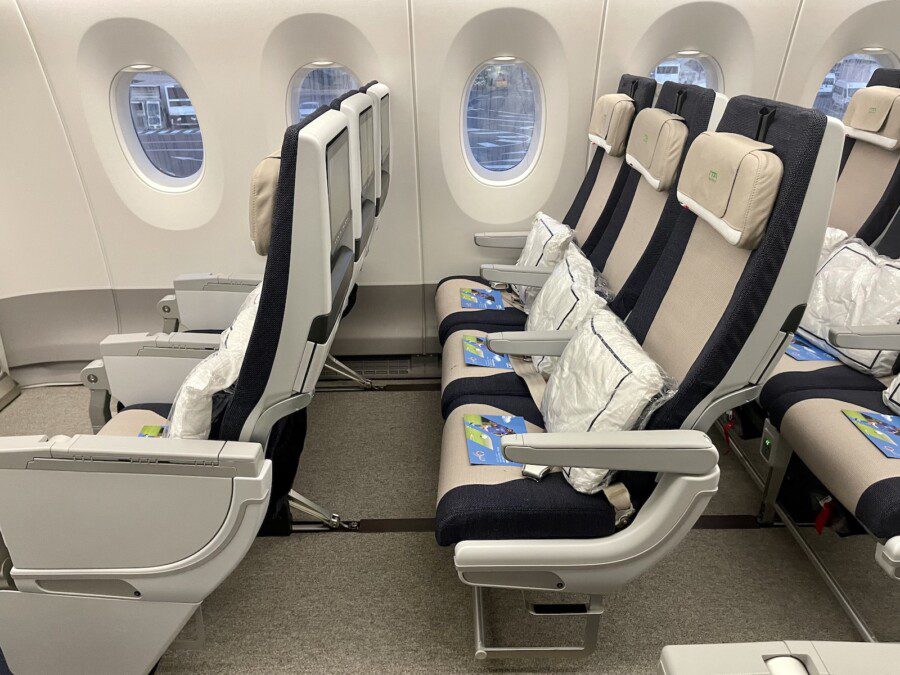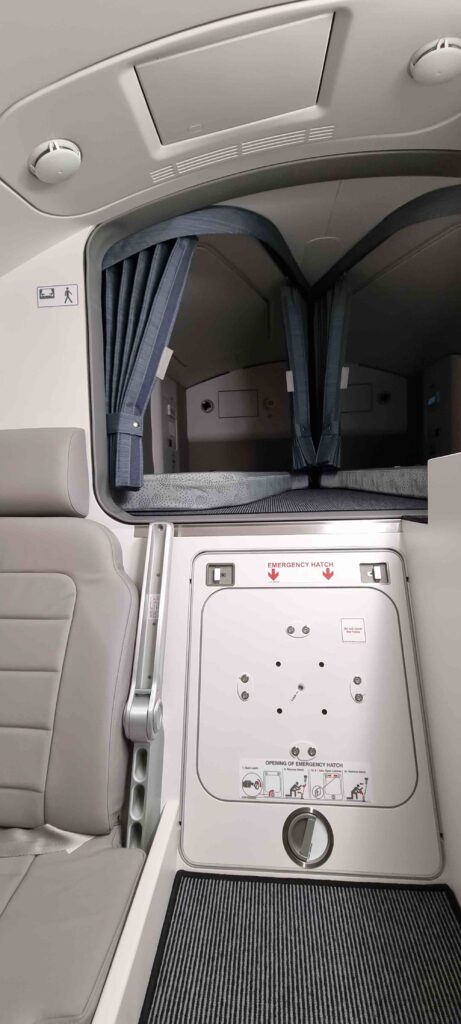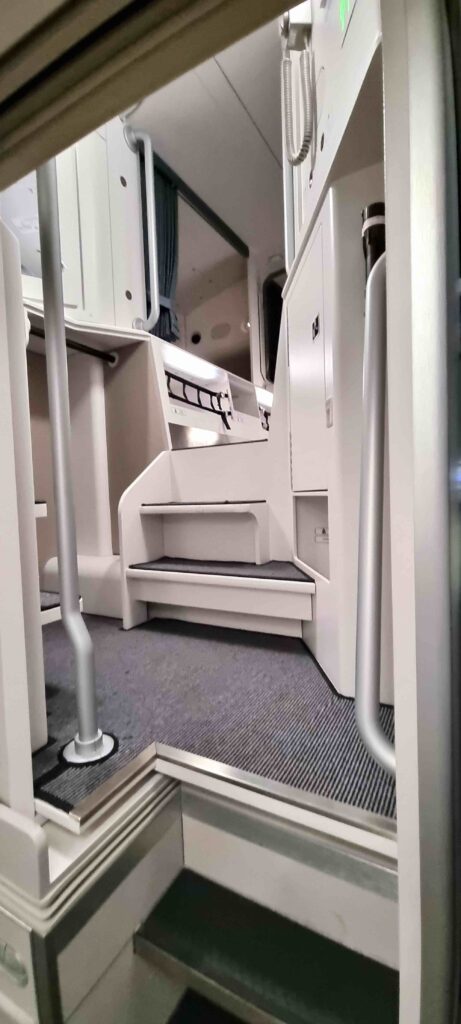From the cockpit to the crew's private rooms: here's what you'll never see about ITA Airways' A350
At the Farnborough show in July, I had the honor of being able to visit and analyze in detail the new flagship of [...]
At the Farnborough Fair of July, I had the honor of being able to visit and analyze in detail ITA Airways' new flagship, the only airline, along with Air Baltic, to participate in the world's most important civil and military aviation fair, in a large pavilion, in cooperation with Airbus.
In this article:
A350, what it looks like
The Airbus 350-900 is a next-generation aircraft, assembled in Getafe, Spain, and Toulouse, France. Unlike normal airplanes that have an aluminum fuselage, this model is made entirely of carbon fiber and titanium.
Fiber has basically two advantages:
- The first is its light weight combined with high mechanical and thermal resistance. This has enabled Airbus engineers to design aircraft that consume less power than previous generations. In some places the fuselage is just over 5 mm thick, behaving exactly like a beer can.
- The second advantage is lower maintenance costs. Each aircraft, after a certain number of flight hours defined by the manufacturer, is x-rayed for possible fatigue microfractures. With metal fuselages, any cracks are repaired by replacing the entire panel. This is a lengthy process that requires the removal of all rivets in order to replace the damaged piece. Carbon fiber, on the other hand, is "cured" using special resins that are injected into the fuselage and work somewhat like glue. After being heated these melt, bridging any fractures in a repair process that dramatically reduces machine downtime.
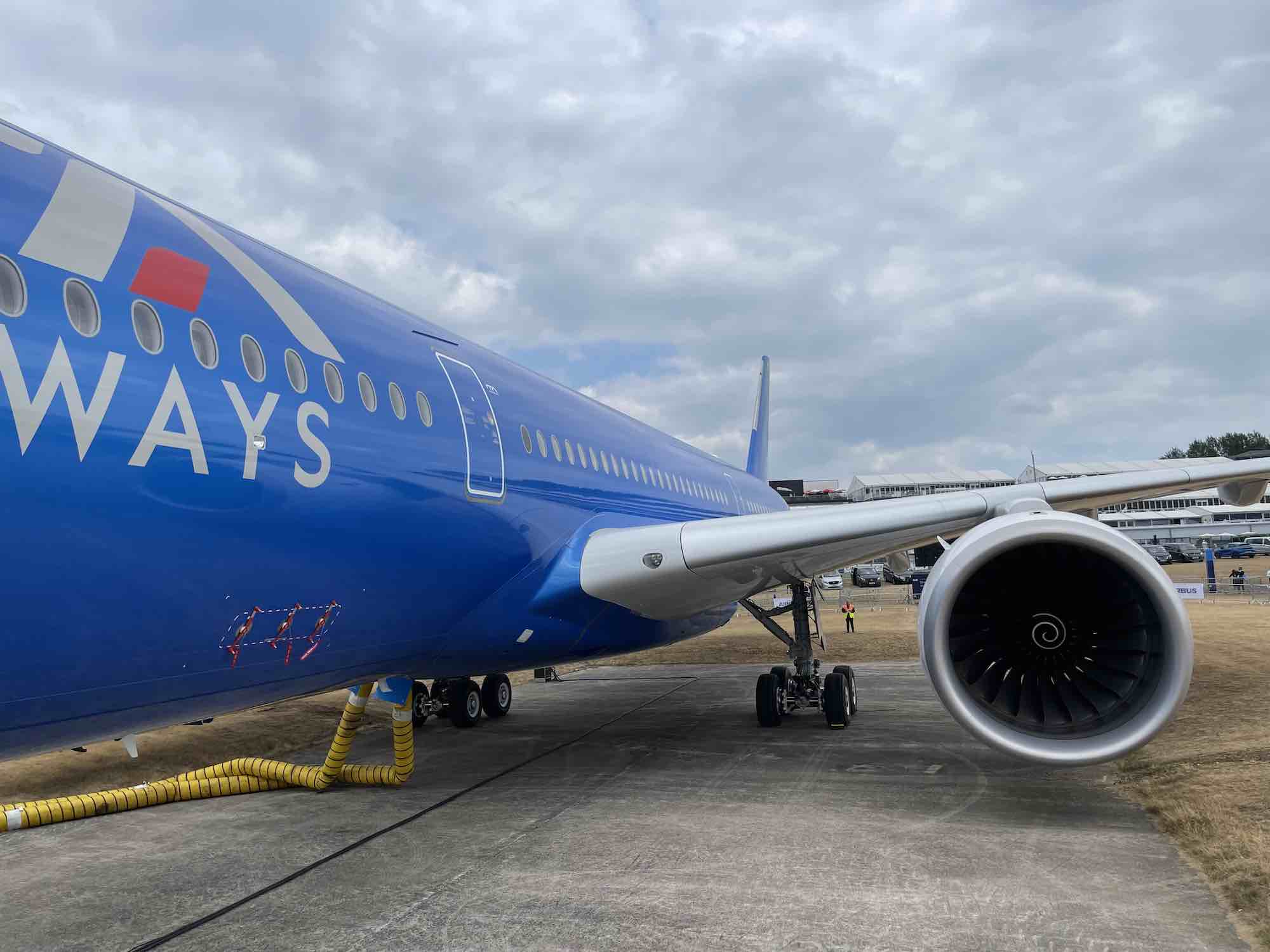
The Airbus A350's clean design features state-of-the-art aerodynamics, A lighter carbon fiber fuselage and wings than the 70%, as well as quieter and more fuel-efficient Rolls-Royce Trent engines. Together, these latest technologies result in unparalleled levels of operational efficiency and sustainability with a 25% reduction in fuel consumption and CO2 emissions compared with previous generation twin-aisle aircraft.
ITA Airways and the A350
ITA Airways currently has five aircraft in service on the routes between Rome and Buenos Aires, New York and Los Angeles, but new routes such as Brazil with a destination on Sao Paulo will arrive in the coming weeks. The aircraft unveiled at the Farnborough Airshow was theA350-900 EI-IFF dedicated to Enzo Bearzot which, after the fair, immediately went on line on 23-7-2022 on AZ608 Rome FCO - New York JFK and back AZ609.
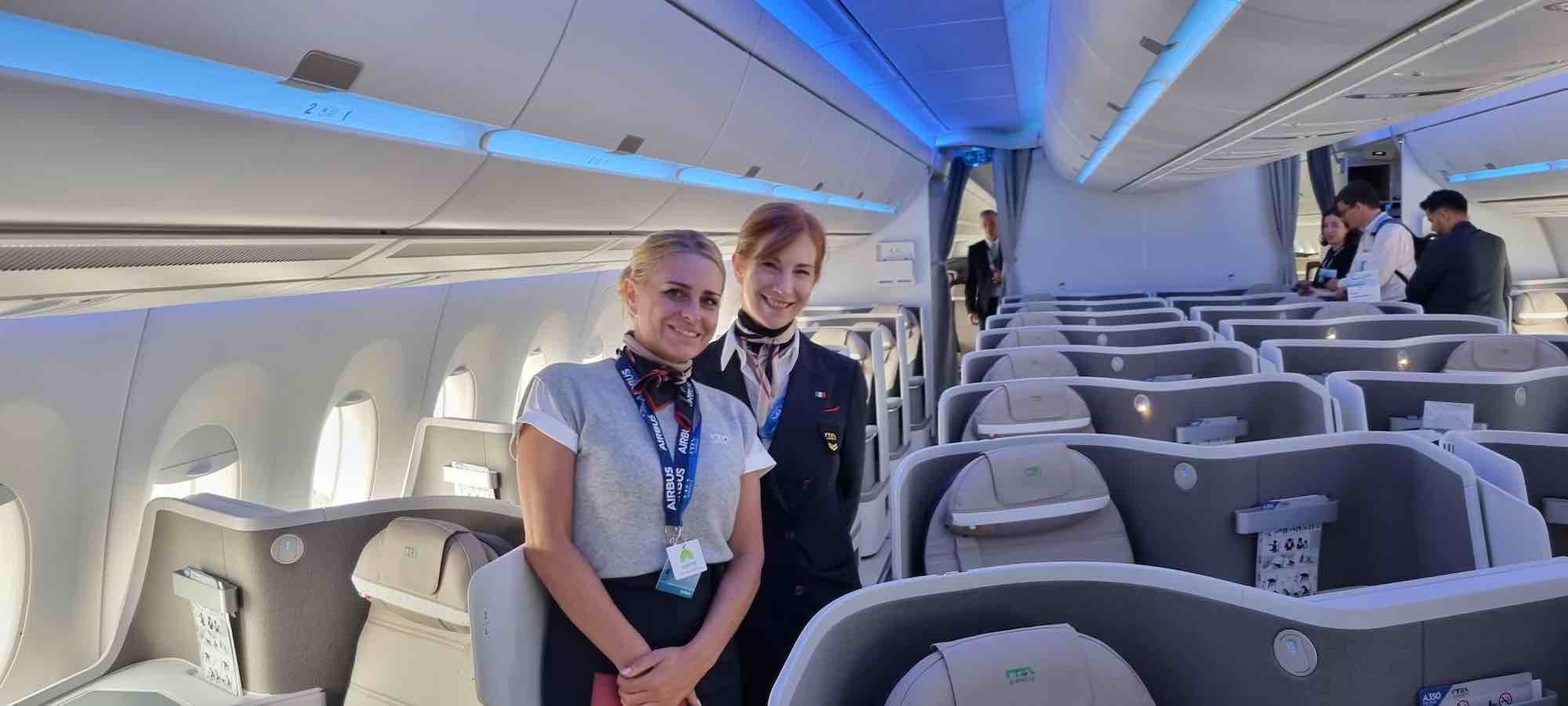
I am welcomed aboard by Alessia's infectious enthusiasm., flight attendant, first with Alitalia and now Ita with 20 years' experience on intercontinental routes. She will be the one to guide me through the discovery of the new aircraft. Guided tours of this kind are extremely rare and difficult to accomplish precisely because these machines, once they enter service, never have to stop. Who better than a hardened traveler led by an experienced stewardess could reveal the secrets behind this new plane.
Starting with the configuration, this plane takes Ita Airways to the top step of quality and comfort in flight. The new Airbus A350-900 has 334 seats, including 33 in Business with full-flat bed seats and 39 Comfort (premium economy) seats.
The configuration is 3-3-3, each session has its own monitor and the pitch varies from 38 inches in business and 31 inches in economy class. The two classes differ in their headrests: cream-colored for business and premium economy and dark for economy.
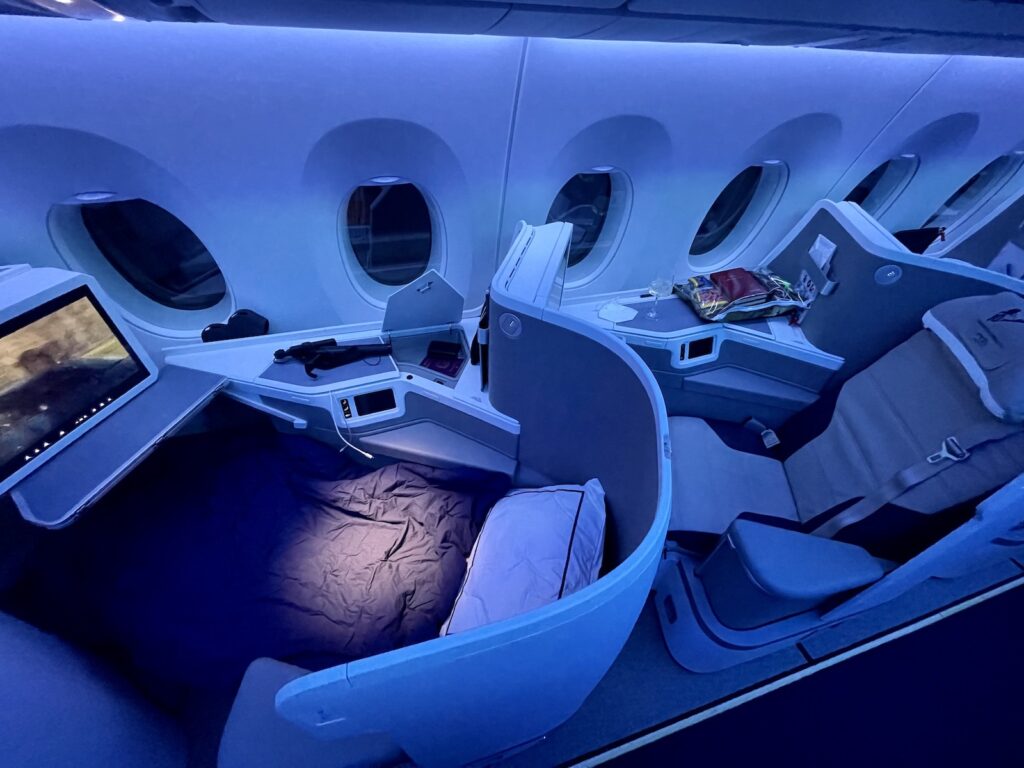
Each business class seat allows independent access to the aisle, and separation with your neighbor is almost total. Great news for business people, less so for traveling couples who will have difficulty looking at each other even when lowering the center divider.
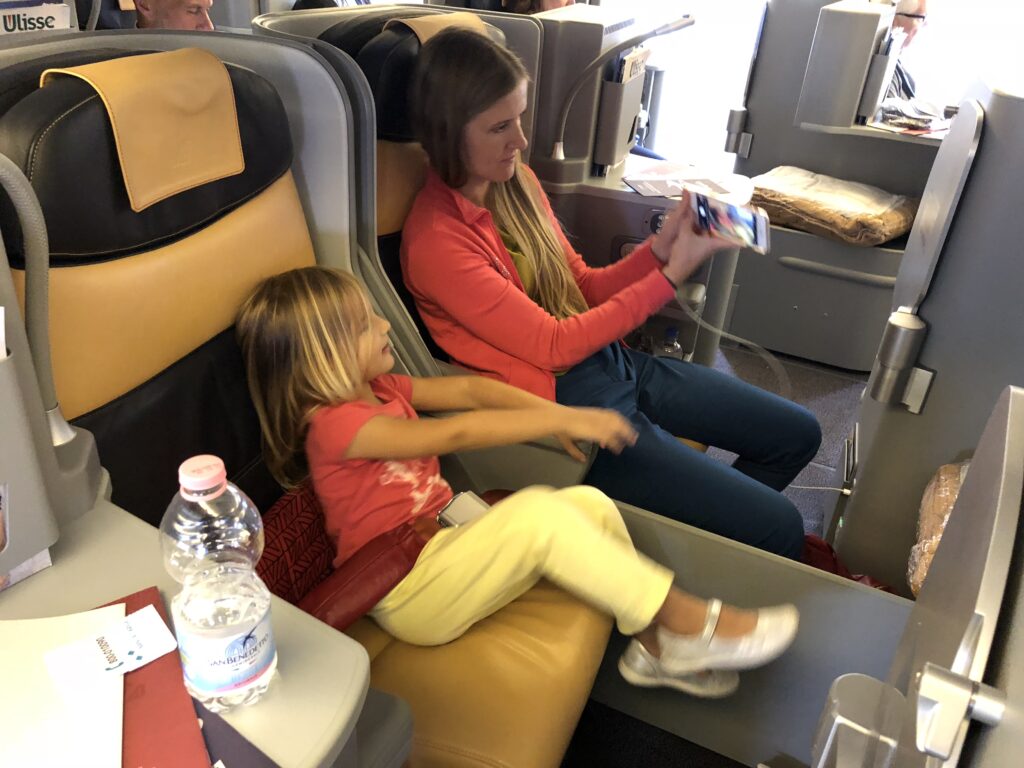
The only flaw, if we are being nitpicky, on this business cabin configuration is that it lacks a "honeymoon" option, which is the joining of the two middle business seats to form a large double bed.
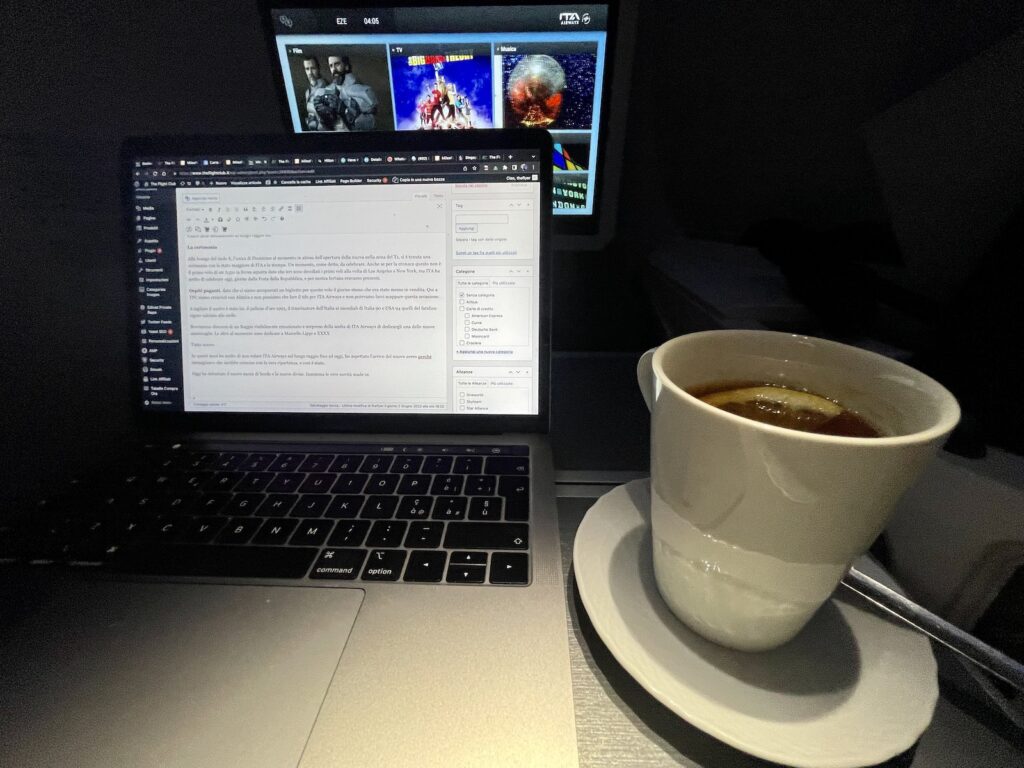
In business, the seat creates a very private environment with plenty of storage lockers. The self-propelled coffee table can be adjusted in height and provides a very solid feel, this is an important detail for those who will have to work with a laptop in mild turbulent conditions. The vast majority of the tray tables wobble making it really uncomfortable to write when in flight. On the other hand, I am not convinced by the location of the USB outlet for charging the cell phone, which is located in a drawer at the side of the seat; I would have preferred a connector near the screen, because the drawer once closed risks bending the power cord.
One of the most interesting features of the new airplane is thehe management of LED lighting, which Airbus says succeeds in reducing the effects of jet lag, improving life for passengers.
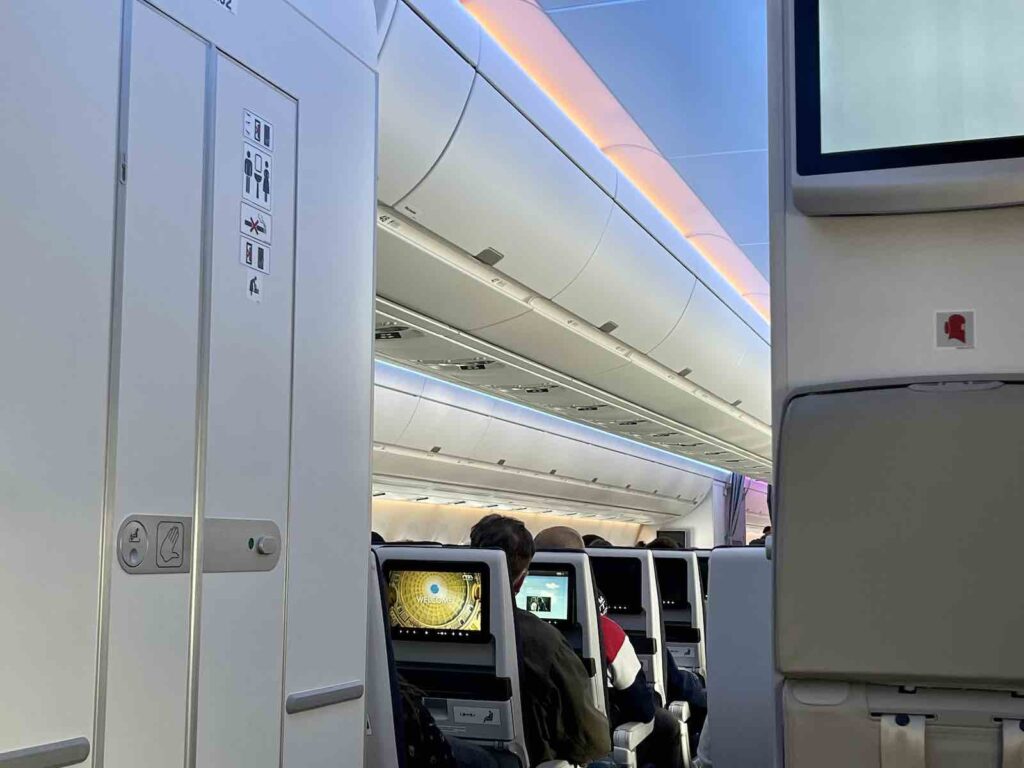
Different light conditions can be artificially recreated inside the plane to mimic natural light conditions. Our bodies, during daylight hours, produce a relatively low amount of melatonin, a hormone that along with other mechanisms contributes to making us feel tired. As light decreases, melatonin levels increase so that we are prompted to rest, a necessary condition for regaining energy. When you are flying, especially in the case of intercontinental travel, this mechanism undergoes some jolts, because moving quickly from one point to another on the planet changes several time zones with a different number of hours of light than usual, which then leads to jet lag. Alessia shows me the different settings. On this plane you will no longer be awakened with a sudden glaring light in your eyes, but the light will change hue according to the different phases of the flight.
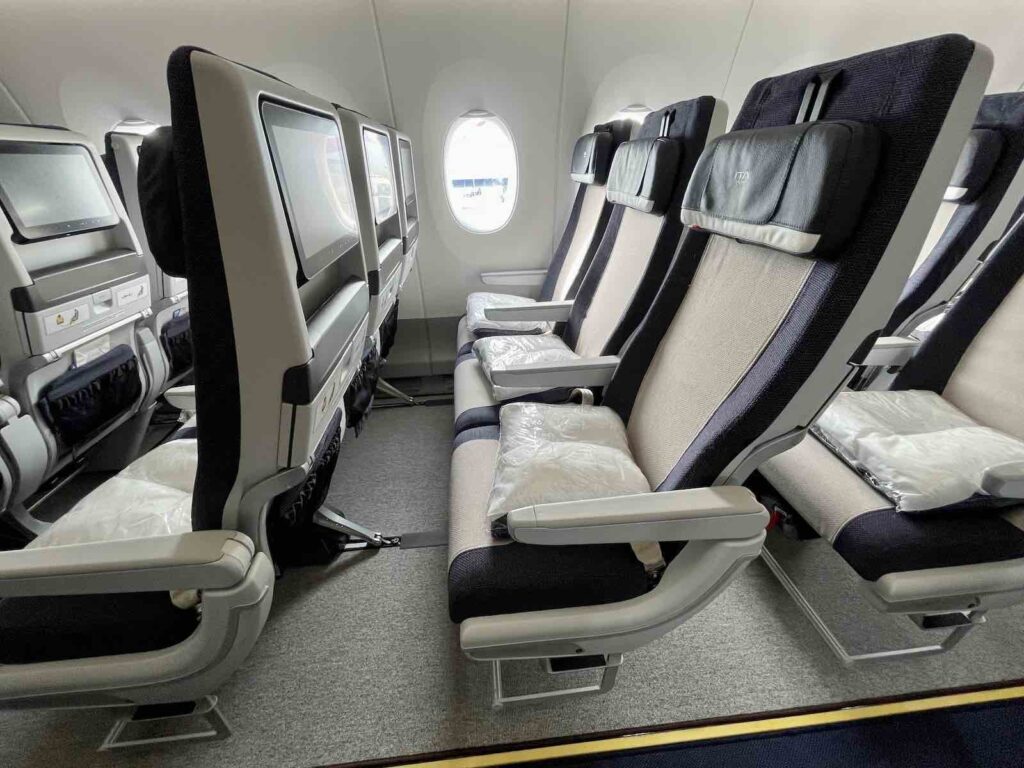
Unfortunately, Airbus has not installed windows that automatically polarize, as they do on the competitor's aircraft, Boeing's 787-9. The manual curtain to operate is always a cause for discussion with other passengers and especially forces the crew to ask passengers to raise or lower the shades during the flight. It is unfortunate that this solution has not been adopted because it is a system that works excellently and allows the passenger, or the crew on landing, to brighten or electrically dim all the windows at the same time.
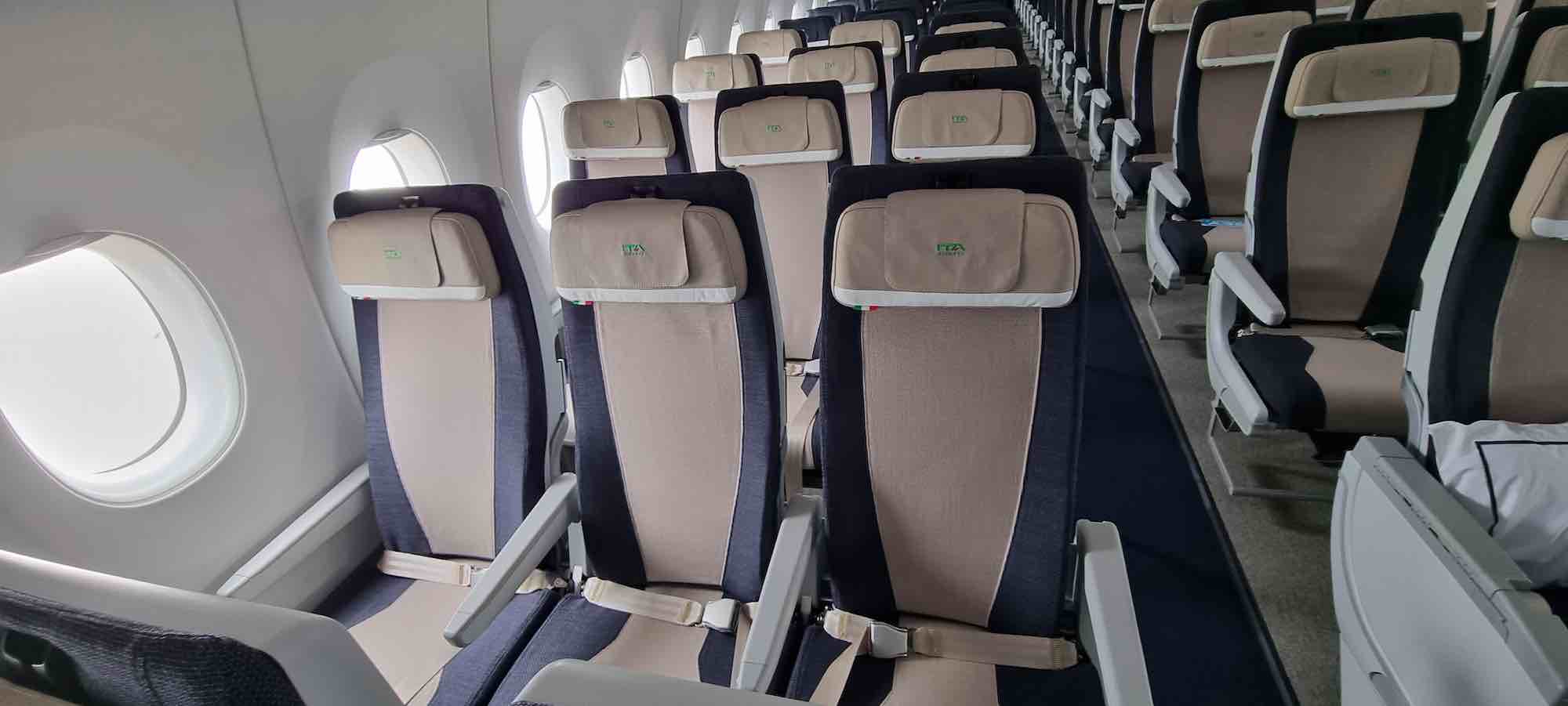
Another advantage that makes flying on an A350 enjoyable is the very advanced air filtration system, which allows a complete cabin air exchange every 2-3 minutes, in Covid times this is no small detail. The cabin is more sterile than an operating room because the filters are able to eliminate even viruses and bacteria in the air. Added to this is a new air management system, which eliminates drafts, several independently adjustable temperature zones, and The increased pressurization in the cabin (about 1,800mt above sea level), which improve the well-being of passengers and staff on board and reduce their fatigue. At other older aircraft the cabin pressure in flight can reach up to 2400 meters. It is like mountain climbing and each passenger will feel this pressure individually. Ears will plug up and skin will quickly become dry, by lowering the pressure the feeling of fatigue and physical stress will increase proportionally. By flying on an ITA Airways intercontinental flight, passengers will arrive at their destination feeling more rested.
Inside the off limits places
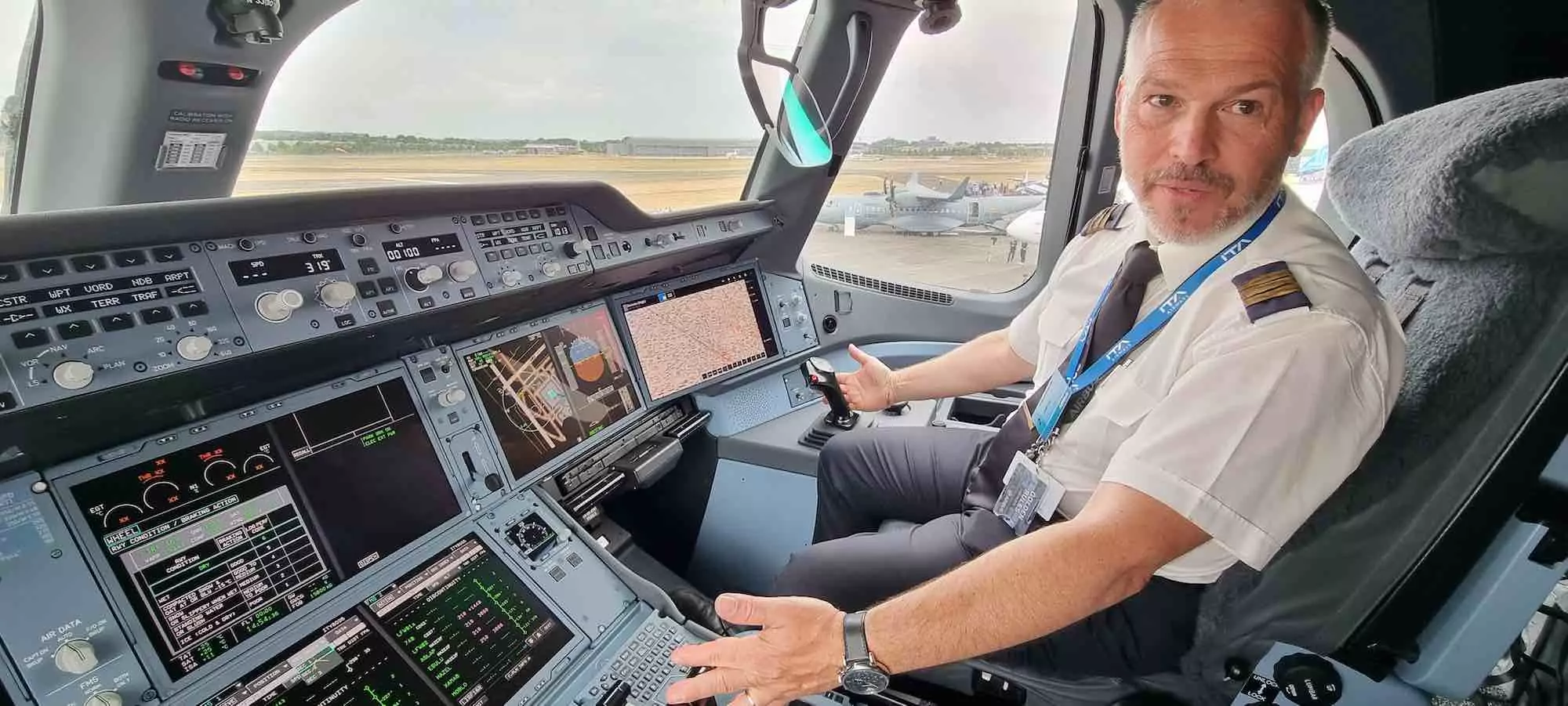
I am greeted by the very kind captain who has been operating for years on international routes; after pleasantries, he seats me in the pilot's seat.
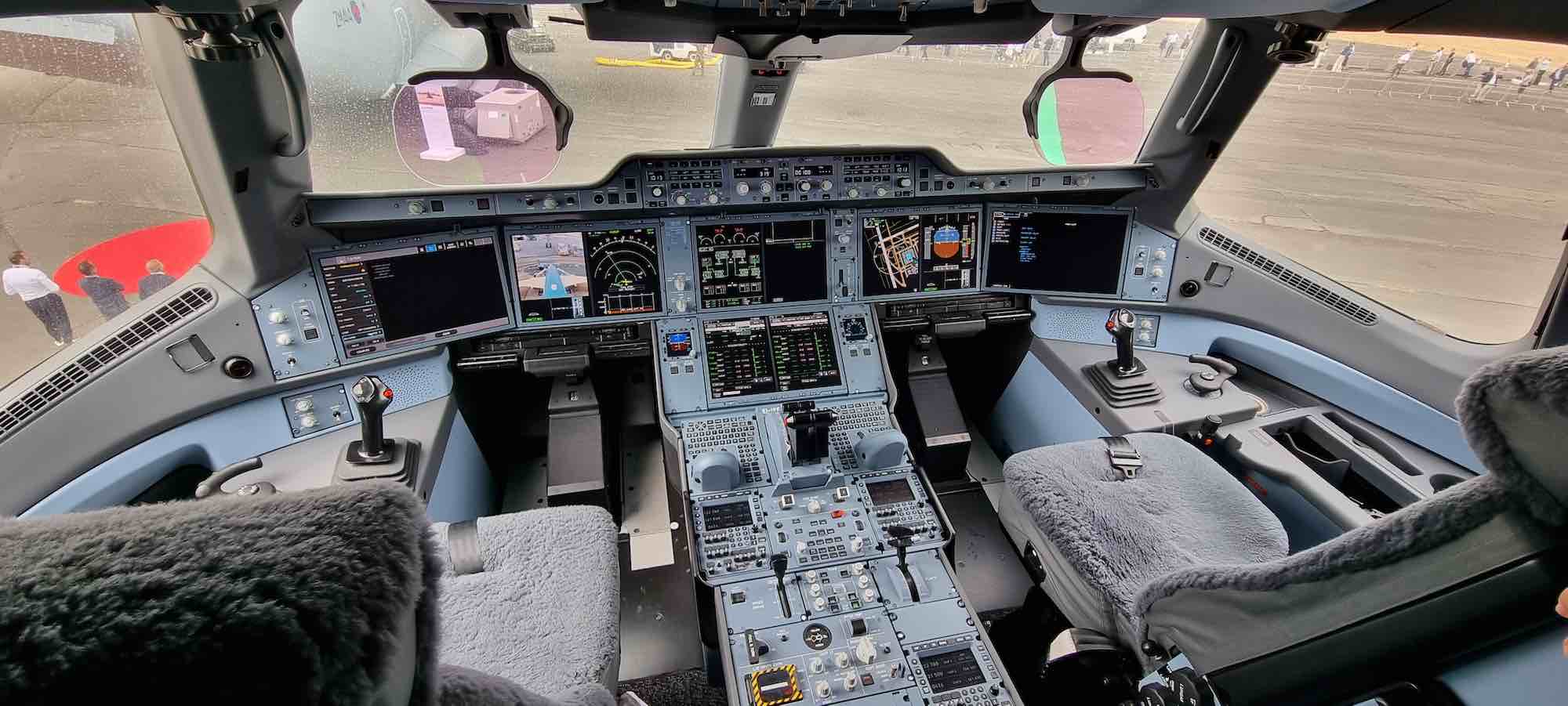
The revised design of the cockpit Of the A350 adopts screens liquid crystal from 15 inches. The first thing one notices upon entering the cabin is the lack of the classic center stick in front of the pilot. Thanks to fly-by-wire systems, the plane is carried with one hand on a side joystick and the other on the throttle of the engines.
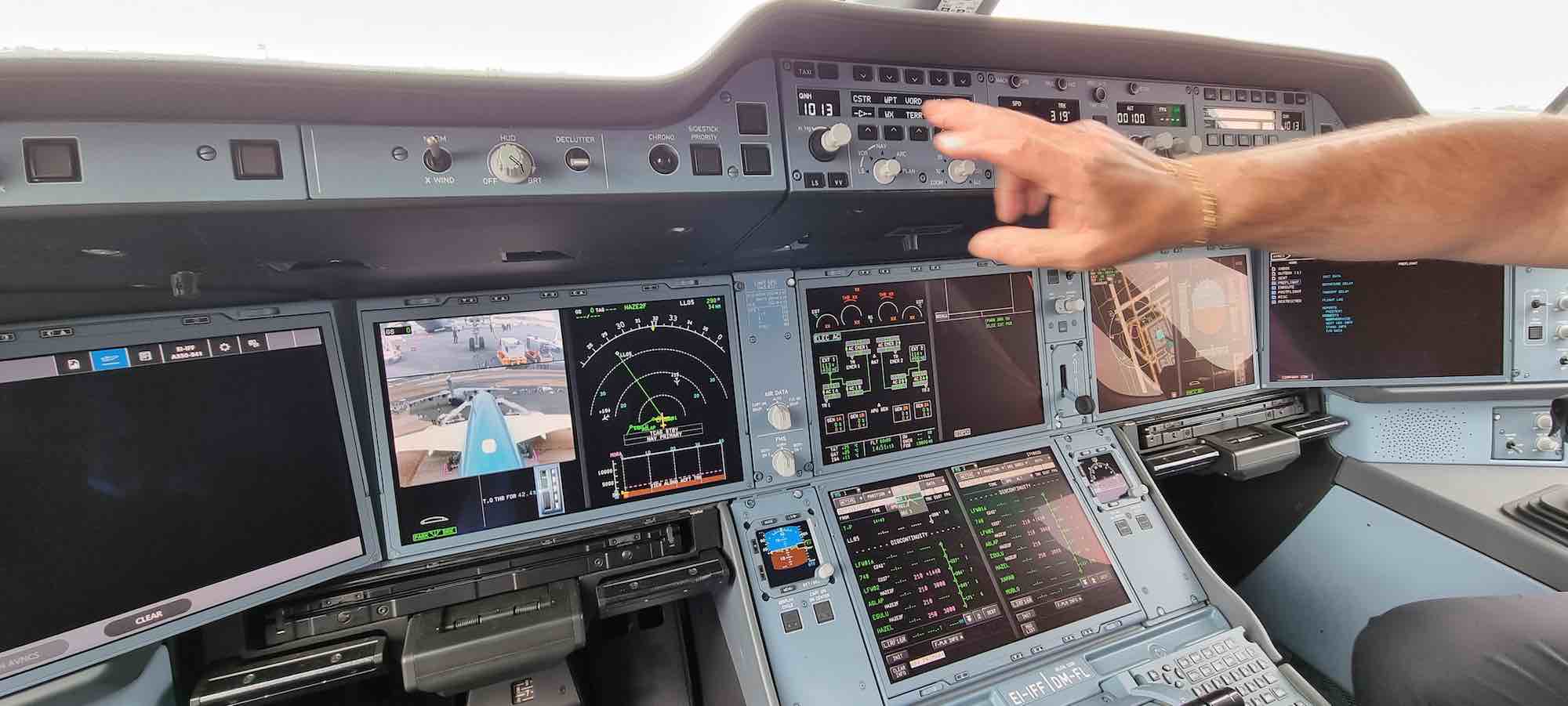
The new six-screen configuration includes two central displays mounted one on top of the other (the lower one above the thrust levers) and a single primary flight/navigation display (for each pilot), with a screen adjacent to the on-board information system. Airbus allows the pilot to calculate before landing, by knowing the weight of the aircraft and setting runway conditions, how many meters he or she will have to travel before stopping. Useful for planning the proper exit connection and subsequent taxi to the staging area. This allows the crew complete planning of the landing, allowing the parking area to be reached quickly.
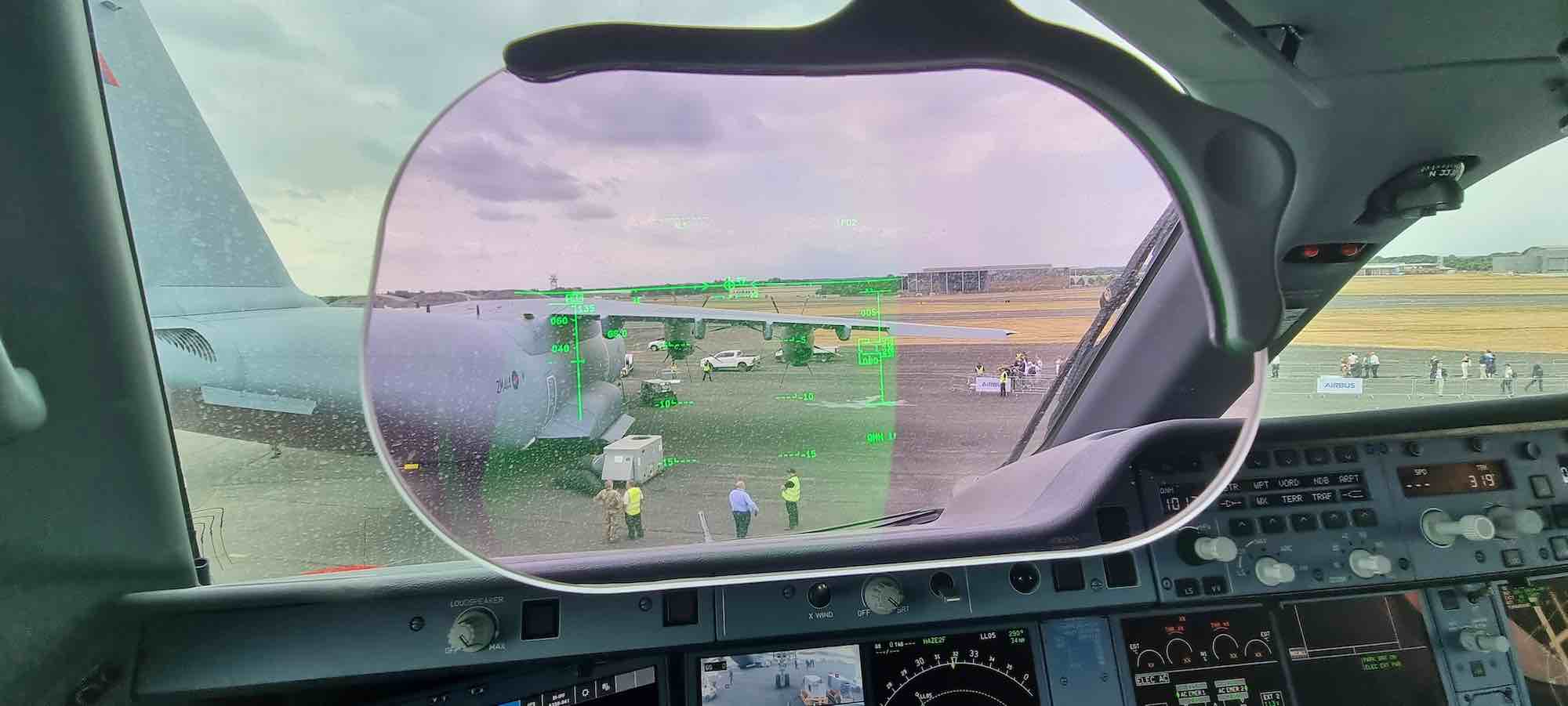
A futuristic head-up display is present in front of the pilot, allowing him to never take his eyes off the track in front of him, showing him essential data such as artificial horizon, speed and altitude.
Avionics is a further development of the concept of integrated modular avionics (IMA) found on the A380. The A350's IMA will handle up to 40 functions (compared to 23 on the A380).
To give you an idea of how complex and refined the safety systems of the new A350 are, I will give you an example.
In 2005, a slow decompression of the plane led to the crash of Helios Airways-operated Flight 522, which was connecting Larnaca to Athens (121 lost their lives). On that flight, shortly after takeoff, all occupants lost consciousness, including pilots due to lack of oxygen. The "ghost" plane with the autopilot on continued to fly for two hours before running out of fuel and crashing.
On the new Airbus 350s there is a function called AED Automated Emergency Descent. If 15 seconds after takeoff the aircraft controls are not touched, the aircraft enters emergency mode. It automatically exits the main aeroute by taking off to the side, 5 miles into a parallel path. After that it begins a controlled descent to an altitude of 3,000 meters. Altitude that is verified by map maps, avoiding any obstacles such as mountains; the system is so complex that the plane is capable on its own of avoiding even dangerous intersections with other aircraft with special maneuvers. All this is done to bring the plane to an altitude where crew and passengers can return to breathing oxygen after any hypoxia.
This system is not much different from the emergency braking that is now mandatory on newly registered cars. Computers have made our lives safer, reducing where possible a whole range of human error.
Immediately outside the cockpit, we find a bathroom for the crew and a door with a cabin to allow rest during long intercontinental journeys. Consider that its big brother the A350-1000 Will be able to fly for 20 consecutive hours, allowing it to connect London with Sydney. Pilots may be deployed for a maximum flight time of 8 hours during 24 consecutive hours, reduced to 6 hours for activity carried out totally during the nighttime arc. This beautiful corner of privacy allows the three-man crew to rest on an armchair and sleep in comfortable bunks similar to those found on sailboats.
There is a second "Crew rest" area and it is at the rear of the plane. It consists of 5 bunks to allow rest for all the rest of the crew on board. Which is impossible, for example, with intercontinental routes operated with single-aisle aircraft such as the A321. It is a very similar solution to the one that Air New Zealand will soon offer economy passengers.
With this configuration, privacy is maximized because passengers will never see the movements of the crew, perhaps sharing the same bathroom. For those who spend hundreds of hours in the air each year, this aspect is critical. Alessia is quick to point out that for them this is a radical change that markedly improves the quality of their work. A rested crew is indeed the key to always serving the passengers on the flight with a smile.
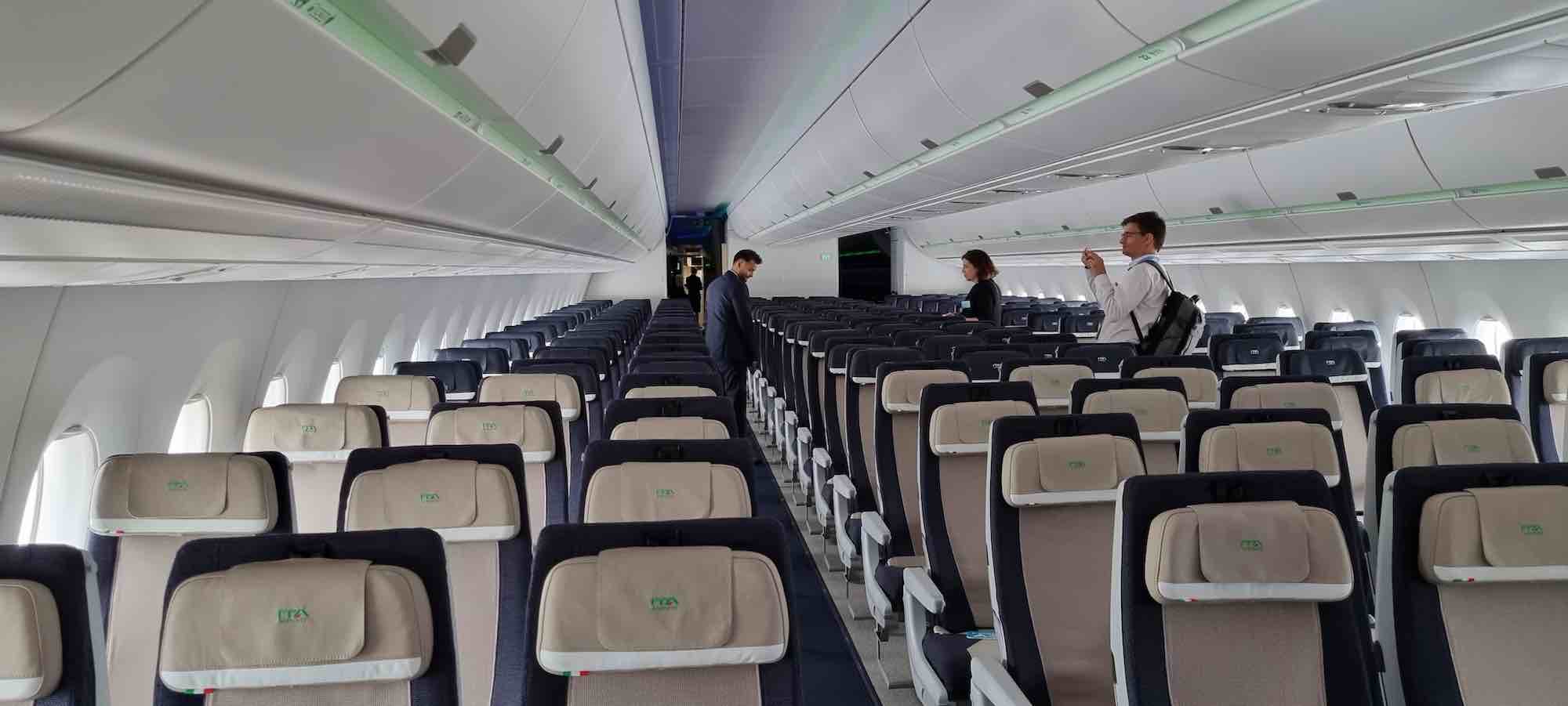
On an intercontinental flight, there are 14 crew members aboard this aircraft. These in turn, divided into team A and team B, in the night hours, when the intensity of service is minimal, rest in special bunks placed in the tail of the plane. Seven people sleep on the outbound flight and on the return flight the group reverses. A curiosity: some of the bunks in the back are physically inside the overhead bins in the last rows of the plane. For this reason, I do not suggest readers book an economy class seat in the last three rows, because you will not be able to use the overhead bins to store your belongings.
How CIDS works
As a frequent user I was finally able to ask how the onboard internal communication system works. And how does the crew communicate any emergencies on board. It's called CIDS (Cabin Intercommunication Data System) and is obviously the most complex. This is where the temperature in different areas of the aircraft, the lights in different phases of the flight are managed. CIDS can be used for standard communications to passengers or for communications between crew. But it also contains the ship's handbook and a thousand other functions to make staff work easy. Internal telephones have not been eliminated, which, somewhat like in hotels, have preset keys for calling each other and alerting the captain that there is an emergency situation on board.
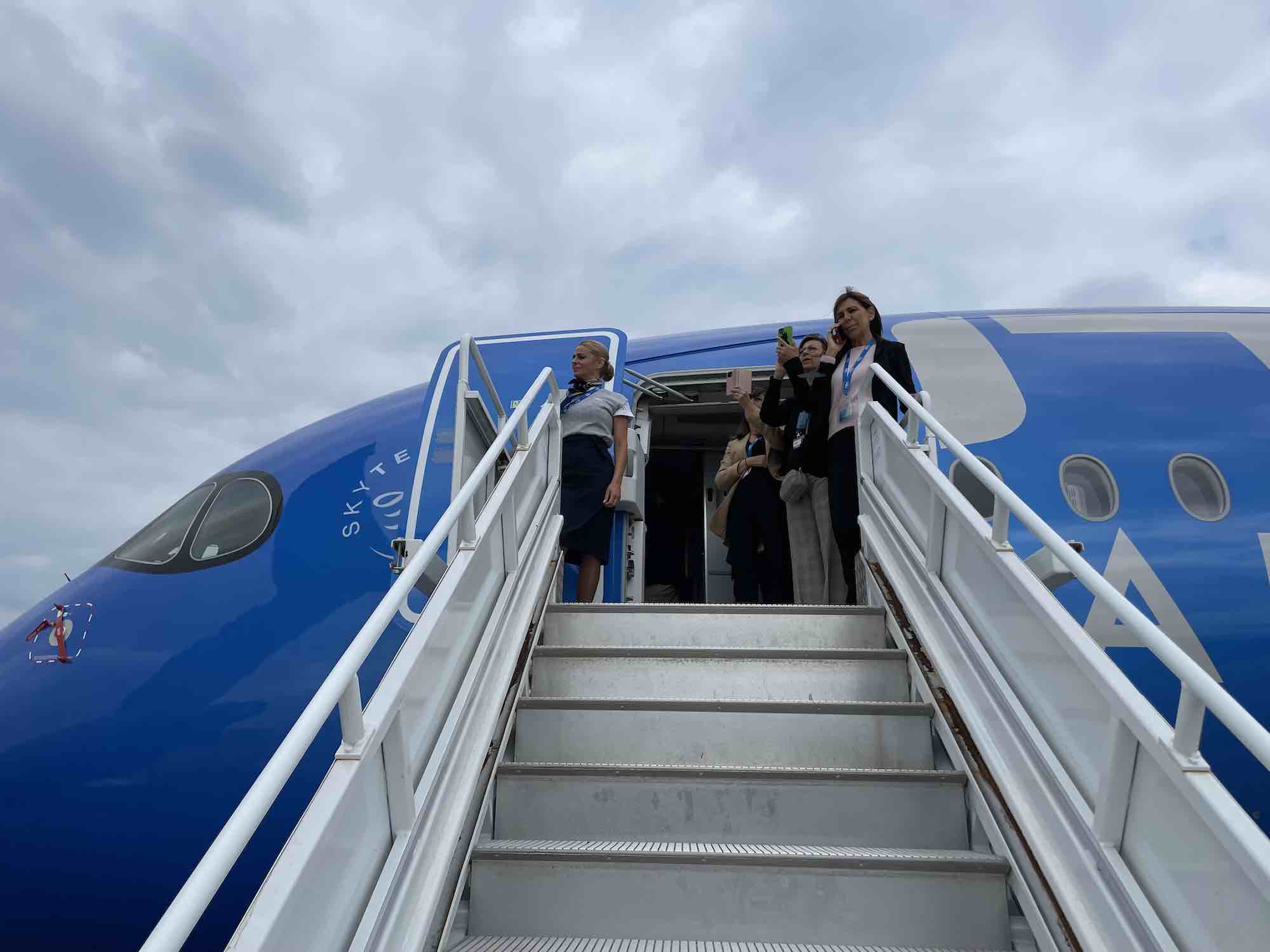
I concluded my visit by asking Alessia her opinion of the new vehicle. Her answer was sharp and clear. With this type of modern aircraft, passengers flying ITA Airways will feel pampered, arrive at their destination more rested, and thus the overall travel experience will benefit. New routes and new planes will arrive soon and will also operate some flights from Milan.
Change of program in sight
For work I have always preferred to fly from Turin with Lufthansa, because it has always provided me with a good number of international connections and good overall quality. Honestly, I have always somewhat snubbed our national airline because of the well-known problems related to the succession of corporate crises. Today, after understanding the spirit that drives this company and seeing with my own eyes the progress and improvements made, I have a great desire to stretch my future travels to America. Stopping over from Rome to fly back with ITA Airways...and I assure you that this is no small thing, because getting a frequent flyer to change habits is so difficult!
Good start, well done!
- 12,000 Mileage Registration Bonus
- Collect miles WITH EACH PURCHASE
- Your miles with no expiration*
- No fees for ATM withdrawals and foreign purchases
- Without having to change banks
- Autonomous card activation
- Multi-function mobile application
- Free travel insurance
- Free credit for up to 7 weeks
- Contactless Payment
- Mastercard® SecureCode

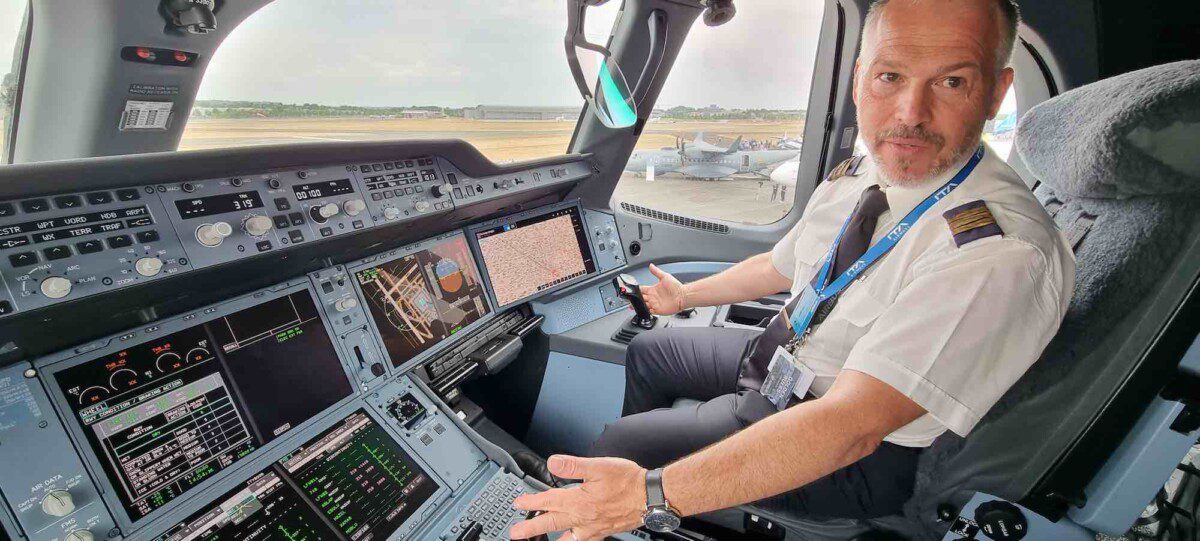

 Skyteam
Skyteam













